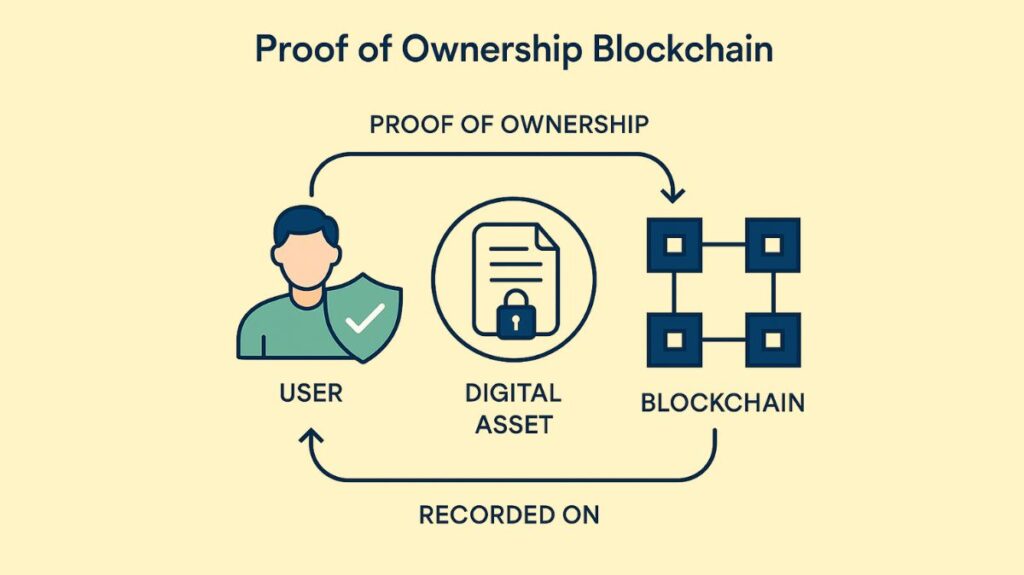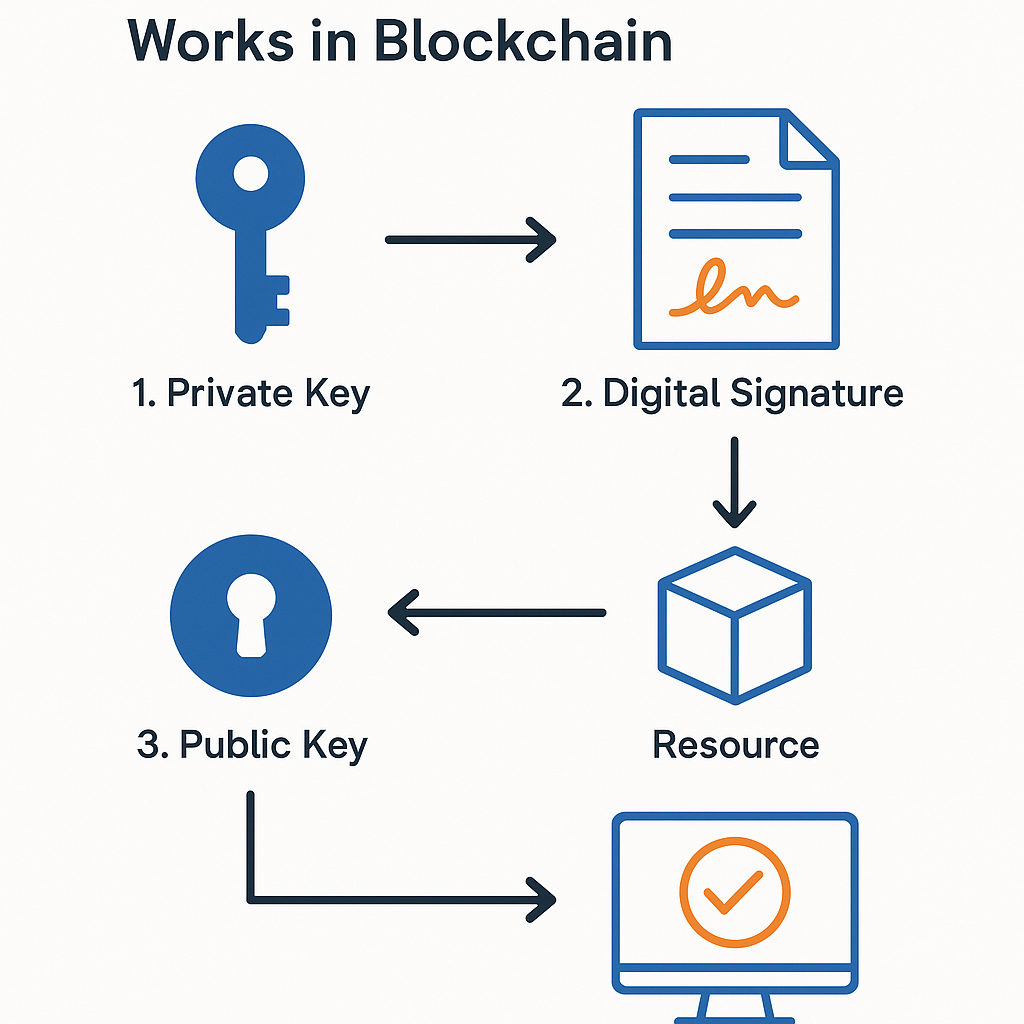Proof of Ownership Blockchain

Blockchain technology’s Proof of Ownership (PoO) is a key idea that makes it possible to safely and verifiably claim ownership of a variety of assets, both digital and tangible. The capacity to demonstrate control over the private key linked to an object is the fundamental component of proof of ownership (PoO).
The conventional reliance on centralized registries, like as banks or government organizations, is replaced by this idea with a decentralized, transparent, and unchangeable ledger. In contrast to more conventional techniques like land deeds, it offers unquestionable evidence of ownership, which is frequently regarded as safer.
You can also read What Is A Bitcoin Address, Types And How Does It Works
How Proof of Ownership Works

The mechanism of PoO is a direct application of the core principles of public-key cryptography and blockchain:
- Every user on a blockchain has a distinct pair of public and private cryptographic keys and hashes. Only the owner has access to the private key, which is a secret. The public key, which is frequently shown as a wallet address, is an identifiable number. The owner digitally signs an item or document’s cryptographic hash with a private key. A hash function generates a fixed-length output from almost any input, ensuring data integrity. This means that even slight input data changes generate a new hash. Because the blockchain only stores this fingerprint or cryptographic digest and not the actual text, privacy is preserved.
- Asset Tokenization: To be managed on a blockchain, an asset must be “tokenized.” This means a digital representation of the asset (a token) is created on the blockchain. This token can be a simple fungible token (like Bitcoin) or a unique, non-fungible token (NFT) for a specific item. The private key is the ultimate proof of ownership, as any transaction, transfer, or action related to the token can only be authorized and digitally signed with its corresponding private key.
- Blockchain Record: The signed hash is then stored on the blockchain with a timestamp. The blockchain is immutable, therefore records (blocks) cannot be erased. Blockchain transactions are irreversible because they are cryptographically entangled with millions of others and mathematically hashed.
- Decentralized Verification: The distributed ledger technology (DLT) ensures that every participant on the chain has an identical copy of these immutable transaction records. Any party can access this open file and audit transactions, allowing for the tracking of asset lifetimes. Anyone can then verify the ownership by using the owner’s public key to validate the digital signature against the recorded hash.
- Verifiable Actions: A user can prove their ownership of a digital asset without revealing their private key by performing verifiable actions, such as:
- Signing a Message: Using their private key, the user can sign a distinct, pre-written message. Anyone using the user’s public key can validate the generated digital signature. The user holds the private key linked to that address and, consequently, the assets contained within, as demonstrated mathematically if the signature is legitimate.
- Microtransaction (Satoshi Test): The user can send a very small amount of cryptocurrency from their wallet to a specific address. The blockchain transaction record, visible to all, serves as an immutable public record of ownership.
Importance and Benefits of PoO
PoO is crucial because it provides:
- Verifiable evidence of ownership.
- Prevention of fraud or disputes.
- Transparent and tamper-proof records on the blockchain.
- Independence from central intermediaries (like registries).
- Enhanced security due to cryptographic hashes.
- Mathematically verifiable digital scarcity of assets which is a key value proposition for any currency or deflationary asset.
- Efficiency as it is a permissionless, borderless, and censorship-resistant technology, allowing anyone to benefit regardless of location.
PoO as a Consensus Mechanism
The term “Proof of Ownership” (PoO) refers to a consensus technique that is employed in some blockchain environments in addition to being a notion of verifiable ownership. In order to track participants and prevent Sybil attacks, this particular algorithm employs distinct pseudonyms created via Enhanced Privacy Identity (EPID) signatures, which may necessitate a Trusted Execution Environment (TEE). As opposed to other popular processes like Proof of Work (PoW) or Proof of Stake (PoS), this consensus model allows the probability of producing a new block to be linked to the quantity of proofs and distinct pseudonyms a user holds.
Applications of Proof of Ownership
The ability to prove ownership in a decentralized and trustless manner has wide-ranging implications across various industries:
- Intellectual Property and Documents: Blockchain technology can be used as a time-stamping service to verify the presence, ownership, and integrity of digital items, including files, emails, images, and intellectual property. They can demonstrate that they were the first to create something. Smart contracts allow artists to claim ownership of digital artwork and maybe earn royalties from resale.
- Virtual Assets and NFTs: Possibly the most well-known contemporary use case. Unique digital or physical assets are represented by NFTs, which also confer total and unquestionable ownership of virtual goods and real estate in metaverses. Beyond just pictures, NFTs are beautiful because they allow the tokenization of nearly anything on the blockchain, providing verifiable digital scarcity and cryptographic support.
- Real estate: By reducing paperwork and speeding up transactions, blockchain technology can track real estate for authenticity and ownership. Property titles can be saved as NFTs on the blockchain, which would eliminate the need for realtors, reduce fraud and litigation, and create an irreversible record of ownership. In addition to serving as a decentralized escrow, smart contracts can help peer-to-peer housing marketplaces.
- Personal Data: Blockchain technology is used by platforms such as Hu-manity.co to provide users with cryptographic keys that restrict and manage the usage of their data, even enabling them to make money off of it.
- Digital Rights Management (DRM): By securely connecting digital or physical assets, blockchain makes it possible for DRM to function well and ensure that no one else may claim them.
- Supply Chain Management: Businesses are able to track the origin and distribution of commodities by using PoO. A blockchain records the ownership transfer each time a product is transferred, guaranteeing an unchangeable record of the product’s path from manufacturer to customer. Each product can be tokenized. This covers uses in the food industry (tracking of origin, temperature management), healthcare (medical data as NFTs for secure access), and customer service (enhancing the effectiveness of communication).
- Fashion: The industry can combat counterfeit luxury goods by introducing QR code tags that offer blockchain proof of ownership, allowing consumers to register their items and verify their authenticity.
- Music: Blockchain’s irreversible proof of ownership and cryptographic safeguards can halt music piracy and provide musicians real-time income and control over their digital property.
- Art: Blockchain, like NFTs, operationalizes the online community value of rarity, demonstrating artworks’ transparent and verifiable digital scarcity. Additionally, smart contracts can be used to pay artists commissions on each subsequent sale of their artwork.
- Collectibles: Blockchain offers chances for NFT collectibles to work with other games and facilitates the transparent digital scarcity of unique products.
- Sport: For esports NFTs, PoO can offer demonstrable digital scarcity and aid in combating fake sporting goods.
Security Considerations
Keeping the owner’s private key secure and confidential is essential to PoO security. The digital assets that a private key controls are likewise rendered inaccessible in the event that the key is lost or stolen. Wallets protect private keys. Private key management recommended practices include hardware wallets, safe storage, and periodic backups. Cybersecurity matters too. Multi-signature wallets can provide an additional degree of protection.
PoO Challenges
- Private key management: Losing it can mean losing proof of ownership.
- Scalability: Registering and verifying many records can be resource-intensive.
- Legal acceptance: Not all jurisdictions accept blockchain-based ownership proof yet.
You can also read Unconfirmed Bitcoin Transactions And Core Concepts In It
